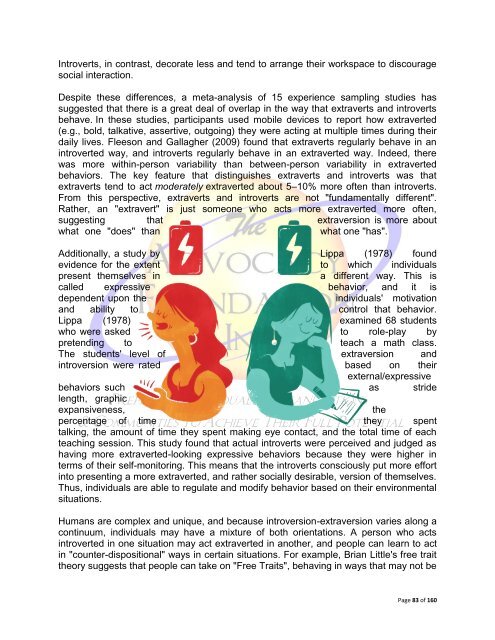The Gift of Introversion
The Gift of Introversion
The Gift of Introversion
You also want an ePaper? Increase the reach of your titles
YUMPU automatically turns print PDFs into web optimized ePapers that Google loves.
Introverts, in contrast, decorate less and tend to arrange their workspace to discourage<br />
social interaction.<br />
Despite these differences, a meta-analysis <strong>of</strong> 15 experience sampling studies has<br />
suggested that there is a great deal <strong>of</strong> overlap in the way that extraverts and introverts<br />
behave. In these studies, participants used mobile devices to report how extraverted<br />
(e.g., bold, talkative, assertive, outgoing) they were acting at multiple times during their<br />
daily lives. Fleeson and Gallagher (2009) found that extraverts regularly behave in an<br />
introverted way, and introverts regularly behave in an extraverted way. Indeed, there<br />
was more within-person variability than between-person variability in extraverted<br />
behaviors. <strong>The</strong> key feature that distinguishes extraverts and introverts was that<br />
extraverts tend to act moderately extraverted about 5–10% more <strong>of</strong>ten than introverts.<br />
From this perspective, extraverts and introverts are not "fundamentally different".<br />
Rather, an "extravert" is just someone who acts more extraverted more <strong>of</strong>ten,<br />
suggesting that extraversion is more about<br />
what one "does" than<br />
what one "has".<br />
Additionally, a study by Lippa (1978) found<br />
evidence for the extent to which individuals<br />
present themselves in<br />
a different way. This is<br />
called expressive behavior, and it is<br />
dependent upon the<br />
individuals' motivation<br />
and ability to control that behavior.<br />
Lippa (1978) examined 68 students<br />
who were asked to role-play by<br />
pretending to teach a math class.<br />
<strong>The</strong> students' level <strong>of</strong> extraversion and<br />
introversion were rated based on their<br />
external/expressive<br />
behaviors such as stride<br />
length, graphic<br />
expansiveness,<br />
the<br />
percentage <strong>of</strong> time they spent<br />
talking, the amount <strong>of</strong> time they spent making eye contact, and the total time <strong>of</strong> each<br />
teaching session. This study found that actual introverts were perceived and judged as<br />
having more extraverted-looking expressive behaviors because they were higher in<br />
terms <strong>of</strong> their self-monitoring. This means that the introverts consciously put more effort<br />
into presenting a more extraverted, and rather socially desirable, version <strong>of</strong> themselves.<br />
Thus, individuals are able to regulate and modify behavior based on their environmental<br />
situations.<br />
Humans are complex and unique, and because introversion-extraversion varies along a<br />
continuum, individuals may have a mixture <strong>of</strong> both orientations. A person who acts<br />
introverted in one situation may act extraverted in another, and people can learn to act<br />
in "counter-dispositional" ways in certain situations. For example, Brian Little's free trait<br />
theory suggests that people can take on "Free Traits", behaving in ways that may not be<br />
Page 83 <strong>of</strong> 160

















